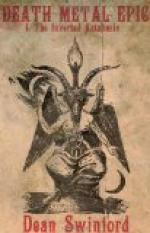The different Scandinavian dialects formed but one language until about 1000 A.D., when they split up into two great groups, the East Northern including the Danish and Swedish; and the West Northern including the Icelandic, Norwegian, and Faroese. Danish literature boasts of some five hundred chivalric ballads (Kjaempeviser), on partly historical and partly mythical themes, which were composed between the fourteenth and sixteenth centuries. It was the Danish translator of the Bible who introduced his countrymen to Charlemagne and Ogier, whose legends received their finished forms at his hands. In 1555 Reynard the Fox was translated into Danish from the French, in 1663 the Heimskringla from the Icelandic, but it was in 1641 that Arrebo composed the Hexaemeron or first real Danish epic. In the nineteenth century Paludan Mueller also wrote epics, which, however, are not very popular outside of his country. The runes of Sweden bear witness to the existence of sundry ancient sagas or epics which perished when Christianity was introduced into the land. In the Middle Ages, a gleeman at the court of Queen Euphemia (1303-12) composed the Euphemiaviser, or romances of chivalry done into Swedish verse. The greatest epic work of Sweden is, however, Tegner’s Frithjof’s Saga (1846), relating the adventures and courtship of an old Scandinavian hero, a work of which a complete synopsis is given in the author’s Legends of the Middle Ages.
The elite of the Norwegians emigrated to Iceland for political reasons during the twelfth and thirteenth centuries. Owing to their geographical isolation and to the long winters, these people were thrown entirely on their own resources for amusement. The hours of darkness were beguiled by tales and songs, so young and old naturally delighted in the recitations of the skalds. This gave birth to an oral literature of great value, and, although many of the works of the skalds have perished, the Icelanders fortunately recovered in 1643,—after centuries of oblivion,—the Elder Edda, an eleventh-century collection of thirty-three poems on mythical and heroic subjects by Saemunt the Wise.
There is also a similar work in prose known as the Younger Edda, by Snorro Sturluson, which contains tales of Scandinavian mythology, and this writer also collected many of the old hero tales in his Heimskringla.
Many of the old sagas have been preserved in more or less perfect forms. They are generally divided into three groups, the first including sagas on historical themes, such as the Egilssaga, the Eyrbyggjasaga, the Njalssaga, the Laxdaelasaga, and the already mentioned Heimskringla.
The second, mythical, or heroic group comprises the Grettis saga and the Volsunga, the finest of all the sagas and one of the main sources of the Nibelungenlied and of Wagner’s Trilogy. This epic has been wonderfully rendered in modern English by William Morris.
In the third and last group are massed together the romantic epics, translations or imitations of the Latin, French, and German epics and romances, relating to Alexander, Charlemagne, Parsival, etc. The finest saga in this group is the Gunnlaugssaga.




